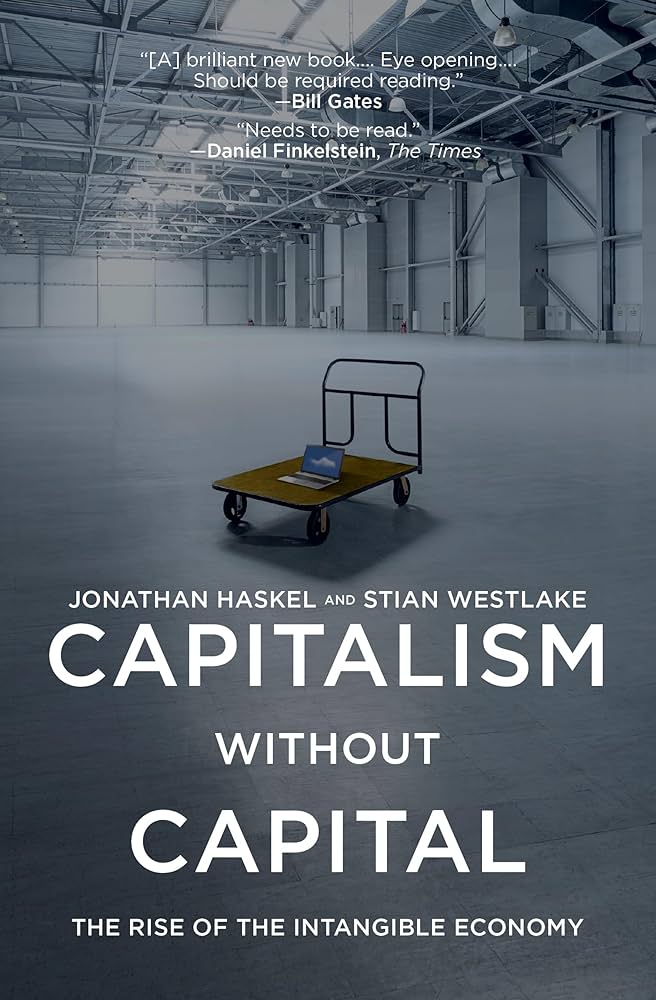Andrei Rogobete: “Capitalism Without Capital” by Jonathan Haskel & Stian Westlake

“Capitalism Without Capital” is an ambitious attempt to go beyond the regular quasi-investment-type advice and explore some of the more profound trends that have occurred in the macro landscape of (mostly) developed western markets. The book hones in on one such major trend, that is, the gradual growth and influence of intangible assets in company valuations and their subsequent effects on equity valuations and the broader economy. The overarching thesis of the book is that “…there is something fundamentally different about intangible investment, and that understanding the move to intangible investment helps us understand some of the key issues facing us today: innovation and growth, inequality, the role of management, and financial and policy reform” (page 7). The authors argue that the two fundamental differences brought on by intangible assets are, (1) we are trying to measure capitalism without counting all the capital and (2), intangible asset rich economies behave differently from their tangible-rich counterparts (ibid).
Jonathan Haskel is Professor of Economics at Imperial College Business School, he is also an external member of the Bank of England’s Monetary Policy Committee. Stian Westlake is Executive Chair of the Economic and Social Research Council (ESRC). The book is aimed at the enquiring reader though it is perhaps more suited for an enquiring reader who also has a specific interest in the world of equity investments and financial markets. Toward this end, the book does require some basic literacy in finance and macroeconomics even though it does not make excessive use of technical jargon. However, some chapters (such as Ch. 3) will clearly be of greater benefit to those that are already familiar with equity research.
The structure of the book is divided into ten chapters. Chapters I to IV focus on the growth of intangible assets, the different methodologies for measuring them and some of the unique economic properties that intangible assets possess. Here the authors claim ‘four S’s’ which they refer back to at various points throughout the book. These stand for the fact that intangible assets are “more likely to be scalable, their costs are more likely to be sunk, and they are inclined to have spillovers and to exhibit synergies with each other” (page 58).
Two interesting observations are worth mentioning here. First, it may come as no surprise that scalability is an underlying feature of intangible assets whereby, unlike their physical counterparts, “…intangible assets, […] can usually be used over and over, in multiple places at the same time. […] [and] at relatively little cost” (page 65). This in turn, gives rise to at least three rather problematic consequences: 1. Intangible-intensive businesses tend to become quite large (the authors use Microsoft, Facebook and Google as examples – page 67). 2. They tend to dominate their respective markets and smaller players may try their luck but usually fail to survive within this oligopolistic competitive environment. 3. Competitors that do to go against highly scalable assets are often left in the difficult second position within a winner-takes-all scenario, leaving the runners-up with very little (page 68).
A second interesting observation is the issue of spillovers. Here the authors point out that high-value intangibles are likely to ‘spillover’ and be replicated or used by other businesses. For instance, it was only after the release of the first iPhone that most other smartphone manufacturers started making devices that look almost identical to the iPhone (page 72). This is problematic for a number of reasons which are enumerated within the chapter (pages 77-79) but chief among these is that spillovers can have a constraining effect on business investment – particularly in key areas such as R&D (ibid).
Chapters V through X move the discussion on to the consequences of the intangible economy. Here the authors argue that the rise of intangibles may play a role in the “…puzzling fall in investment and productivity growth seen in major economies in recent years” (page 91). One of the several arguments put fourth is that the dominance of a few major actors in the marketplace “…raises the productivity and profits gap between the leaders and the laggard firms. This could help explain how low levels of investment coexist with high rates of return…” (page 116).
The final chapters focus on some possible ways forward in terms of policy and wider market action. The author proposes a shift in “…the public policy agenda” where the focus should be on “…facilitating knowledge infrastructure – such as education, Internet and communications technology, urban planning, and public science spending…” (page 241). Good intentions but one cannot help but feel that the proposals put fourth will ultimately struggle to solve the issues raised by intangibles.
There are also other perhaps more contentious points within the book. For instance, the discussion on intangibles and the rise of inequality in Chapter 6 will no doubt raise eyebrows amongst readers. The authors draw a string of rather naïve socioeconomic conclusions, from overestimating the attractiveness of large urban cities (if anything, the post-Covid trend has been quite the opposite), to far-flung connections in claiming that Brexit voters and Trump supporters are more likely to “…score low on tests for the psychological trait of openness to experience. Openness to experience seems to be important for the kind of symbolic-analysis jobs that proliferate as intangibles become more common” (page 143), therefore contributing to increasing inequality. In their defence however, the authors make an admission in the concluding chapter of the book that their analysis of the implications for the wider economy “…is inevitably speculative” (page 242).
In summary, despite some shortcomings there is a lot to applaud within the book. It establishes a novel case for the rise of intangible assets and why they matter and brings a compelling perspective on the implications of the intangible asset economy. Although the enquiring reader may find much use within its pages, the book is really best suited for those with a specific interest in company valuations (fundamental equity research), macro trends, and the wider world of investment and asset management.
Capitalism Without Capital: The Rise of the Intangible Economy by Jonathan Haskel & Stian Westlake was first published in 2018 by Princeton University Press (ISBN 9780691183299, 0691183295), 296pp.
Andrei E. Rogobete is Associate Director at the Centre for Enterprise, Markets & Ethics. For more information about Andrei please click here.

